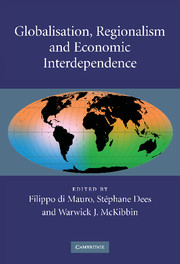Book contents
- Frontmatter
- Contents
- List of figures
- List of tables
- List of contributors
- Preface
- Introduction
- 1 International linkages in the context of global and regional integration
- 2 Trade integration of the central and eastern European countries and China: has it reached potential?
- 3 Patterns and determinants of production fragmentation in world manufacturing trade
- 4 Going global: trade, internationalisation of production and domestic performance of euro area firms
- 5 Globalisation and the trade channel in the euro area
- 6 Gauging the labour market effects of international trade openness: an application to the US manufacturing sector
- Index
- References
4 - Going global: trade, internationalisation of production and domestic performance of euro area firms
Published online by Cambridge University Press: 02 September 2009
- Frontmatter
- Contents
- List of figures
- List of tables
- List of contributors
- Preface
- Introduction
- 1 International linkages in the context of global and regional integration
- 2 Trade integration of the central and eastern European countries and China: has it reached potential?
- 3 Patterns and determinants of production fragmentation in world manufacturing trade
- 4 Going global: trade, internationalisation of production and domestic performance of euro area firms
- 5 Globalisation and the trade channel in the euro area
- 6 Gauging the labour market effects of international trade openness: an application to the US manufacturing sector
- Index
- References
Summary
Introduction
Recent empirical research highlights the fact that firms show a large degree of heterogeneity in their productivity, size, export intensity and propensity to invest and produce abroad and react differently to the increased trade openness and to the broader structural changes associated with increased regional and worldwide economic integration. International trade models that specifically address firm heterogeneity bring to the fore a number of previously unexplored channels through which the international activity of firms, through exporting (which has received most attention) or outward FDI, is linked to a country's productivity and, therefore, to its competitiveness on international markets (e.g. Melitz, 2003, Bernard et al., 2003, and Helpman et al., 2004).
In a nutshell, the most widely cited predictions and testable hypotheses of the models accounting for firm heterogeneity are twofold. First, firms that serve foreign markets are assumed to be more productive than their purely domestic competitors. The extension by Helpman et al. (2004) also predicts that firms investing abroad are the most productive, followed by exporters and purely domestic firms. Second, once countries open up to trade this modifies the set of firms that trade and invest abroad as well as the range of destinations covered and the set of goods traded (the so-called ‘extensive margin of trade’), leading to important effects on international trade flows via changes in aggregate productivity through the reallocation of factors of production among different types of firms.
- Type
- Chapter
- Information
- Globalisation, Regionalism and Economic Interdependence , pp. 73 - 101Publisher: Cambridge University PressPrint publication year: 2009

